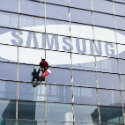
Samsung has climbed aboard the 6G train, setting out its vision for next-generation mobile and predicting it could debut as early as 2028.
The South Korean electronics giant has waded into the contentious 6G tech and geopolitical battle in a new white paper.
Samsung isn't the first to share its 6G views, but its thinking is interesting because of its broad role in the tech ecosystem, ranging from chips and displays to devices and networks.
Samsung expects ITU-R will begin work on 6G next year and, noting the increasingly short development cycle for each new generation, forecasts initial commercial rollouts in 2028 and possible mass commercialization in 2030.
It expects 6G will support a connection density ten times greater than that of 5G. To do that will require a peak rate of 1,000 Gbit/s and a user-experienced rate of 1 Gbit/s, compared with the 5G peak rate of 20 Gbit/s.
The network will also need to deliver end-to-end latency below 1ms and to be twice as spectrally efficient and twice as energy efficient as 5G.
The paper says it is "inevitable" that next-gen mobile will utilize the terahertz (THz) bands, i.e., from 100GHz to 10THz. As with mmWave for 5G today, these high frequencies are largely virgin territory that will enable massive wideband channels, up to tens of gigahertz in breadth, Samsung says.
But it acknowledges the difficulties of working at such high frequencies, with severe path loss, challenges in designing and building all parts of the network, and almost certainly requiring new antenna arrays and waveforms.
The paper canvasses some likely 6G applications, such as "high-fidelity mobile hologram," requiring data transmission rates hundreds of times greater than 5G, and "truly immersive" apps that combine VR, AR and mixed reality.
These future applications will require extensive computation capabilities. But those heavy processing and throughput demands will mean real-time offload at a level well beyond today's MEC offload, requiring hyper-fast data rates and extremely low latencies, aided by AI.
Samsung says that, in addition to the traditional fixed basestations, the network must be capable of adding moving basestations "as well as non-terrestrial components, e.g., airplanes, urban air mobility (UAM) systems, low earth orbit (LEO) and geo-stationary orbit (GEO) satellites, and high altitude platform stations (HAPS)."
To handle this would require an automated network that can add and configure the new connection nodes in a mesh configuration when needed – for example, providing connectivity for people using public transport.
Samsung also expects dynamic spectrum sharing to maximize use of under-utilized spectrum, especially in low-frequency ranges.
"6G should be designed to achieve true communications and computing convergence so that devices can seamlessly utilize the computing power available in the network," Samsung said.
The network would need AI embedded in all 6G system components, ensuring each can acquire and evaluate a massive amount of real-time information.
— Robert Clark, contributing editor, special to Light Reading
Read more about:
AsiaAbout the Author(s)
You May Also Like











